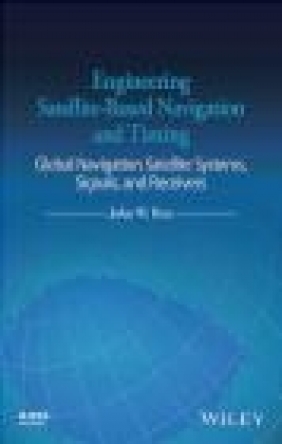Engineering Satellite-Based Navigation and Timing
John Betz
Engineering Satellite-Based Navigation and Timing
John Betz
- Wydawnictwo: John Wiley
- Rok wydania: 2013
- ISBN: 9781118615973
- Ilość stron: 672
- Oprawa: Twarda
Niedostępna
Opis: Engineering Satellite-Based Navigation and Timing - John Betz
This book describes the design and performance analysis of satnav systems, signals, and receivers, with a general approach that applies to all satnav systems and signals in use or under development. It also provides succinct descriptions and comparisons of each satnav system. * Clearly structured, and comprehensive depiction of engineering satellite-based navigation and timing systems, signals, and receivers * GPS as well as all new and modernized systems (SBAS, GLONASS, Galileo, BeiDou, QZSS, IRNSS) and signals being developed and fielded * Theoretical and applied review questions, which can be used for homework or to obtain deeper insights into the material * Extensive equations describing techniques and their performance, illustrated by MATLAB plots * New results, novel insights, and innovative descriptions for key approaches and results in systems engineering and receiver design If you are an instructor and adopted this book for your course, please email [email protected] to get access to the instructor files for this book. John Betz s book is a welcome and much needed addition to the GNSS literature. The title includes engineering and the book contents and clarity do not disappoint. All GNSS and their signal structure descriptions are rightfully integrated from the start. The organization and detailed treatment of the systems signal engineering and receiver processing are superb. Text and formulas are supported by highly informative figures in color to facilitate understanding. Questions inserted at the end of selected chapters will help readers to test their skills. The high quality reflects the extensive experience and knowledge of the author. The book is a must for GNSS engineers and graduate students. The use of high quality glossy paper results in a practical format to read and carry around. Dr. Gerard Lachapelle Professor Emeritus and Faculty Professor Geomatics Engineering Schulich School of Engineering University of CalgaryPreface xv Acknowledgments xvii Useful Constants xix List of Acronyms and Abbreviations xxi About the Author xxvii 1 INTRODUCTION 1 1.1 Satnav Revolution 2 1.2 Basic Principles of Satnav 5 1.3 Satnav Attributes 12 1.4 Book Structure and How to Use This Book 12 1.5 More to Explore 14 Reference 15 PART I SYSTEM AND SIGNAL ENGINEERING 17 2 SATELLITE ORBITS AND CONSTELLATIONS 19 2.1 Kepler s Laws 20 2.2 Orbital Deviations from Ideal 25 2.3 Constellations 26 2.4 Useful Geometry Calculations 30 2.5 Summary 35 Review Questions 35 References 36 3 SATNAV SIGNALS 37 3.1 Signals, Signal Processing, and Spreading Modulations 38 3.2 Effects of Doppler and of Ionospheric Propagation 59 3.3 Satnav Signal Characteristics 65 3.4 Satnav Signal Structure 86 3.5 Summary 92 Review Questions 92 References 99 4 LINK BUDGETS 102 4.1 Free-Space Path Loss 103 4.2 Calculating Maximum and Minimum Specified Received Power in Signal Specifications 107 4.3 Terrestrial Link Budgets 112 4.4 Building Penetration and Foliage Losses 116 4.5 Summary 119 Review Questions 119 References 120 5 CORRELATOR OUTPUT SNR, EFFECTIVE C/N0, AND I/S 122 5.1 Channel Model and Ideal Receiver Processing 122 5.2 Correlator Output SNR With No Interference 125 5.3 Correlator Output SNR With Interference: Spectral Separation Coefficients and Processing Gain 127 5.4 Effective C/N0 129 5.5 Interference-to-Signal Power Ratios and Effective C/N0 130 5.6 A Deeper Look at Spectral Separation Coefficients 130 5.7 Multiple Access Interference and Aggregate Gain of a Constellation 133 5.8 Summary 135 Review Questions 136 References 138 6 ERROR SOURCES AND ERROR CHARACTERIZATION 139 6.1 Sources of Error in Satnav Positioning and Timing Calculation 140 6.2 Dilution of Precision and Error Measures 146 6.3 Positioning Errors for Standalone and Differential Satnav Receivers 150 6.4 Other Error Sources 152 6.5 Summary 153 Review Questions 154 References 155 PART II SATNAV SYSTEM DESCRIPTIONS 157 7 NAVSTAR GLOBAL POSITIONING SYSTEM 163 7.1 GPS History and Plans 165 7.2 GPS Description 167 7.3 GPS Signals 168 7.4 Summary 196 Review Questions 197 References 198 8 SATELLITE-BASED AUGMENTATION SYSTEMS 201 8.1 SBAS History and Plans 202 8.2 SBAS Description 204 8.3 SBAS Signals 205 8.4 Summary 209 Review Questions 210 References 211 9 GLONASS 212 9.1 GLONASS History and Plans 213 9.2 GLONASS Description 214 9.3 GLONASS Signals 215 9.4 Summary 222 Review Questions 224 References 224 10 GALILEO 226 10.1 Galileo History and Plans 227 10.2 Galileo Description 228 10.3 Galileo Signals 230 10.4 Summary 248 Review Questions 249 References 250 11 BEIDOU SYSTEM 252 11.1 BDS History and Plans 253 11.2 BDS Description 254 11.3 BDS Signals 257 11.4 Summary 262 Review Questions 264 References 264 12 QUASI-ZENITH SATELLITE SYSTEM 266 12.1 QZSS History and Plans 267 12.2 QZSS Description 268 12.3 QZSS Signals 270 12.4 Summary 280 References 281 13 INDIAN REGIONAL SATELLITE SYSTEM 282 13.1 IRNSS History and Plans 283 13.2 IRNSS Description 283 13.3 IRNSS Signals 284 13.4 Summary 289 References 289 PART III RECEIVER PROCESSING 291 14 RECEIVER FRONT END 297 14.1 Front-End Components 298 14.2 Front-End Noise Figure 321 14.3 Front-End Architectures and Frequency Plans 323 14.4 Summary 328 Review Questions 329 References 331 15 ANALOG-TO-DIGITAL CONVERSION 333 15.1 Introduction to Analog-to-Digital Conversion and Automatic Gain Control 334 15.2 Linear Analog-to-Digital Conversion 338 15.3 Precorrelator Analog-to-Digital Conversion The Digitizing Correlator 340 15.4 Summary 362 Review Questions 362 References 363 16 ACQUISITION 364 16.1 Initial Conditions for Acquisition 367 16.2 Initial Synchronization Basics 370 16.3 Initial Synchronization Computation 383 16.4 Initial Synchronization Performance 392 16.5 Other Aspects of Acquisition 396 16.6 Summary 401 Review Questions 403 References 404 17 DISCRETE-UPDATE TRACKING LOOPS 406 17.1 Discrete-Update Tracking Loop Formulation 408 17.2 Discrete-Update Tracking Loop Design 412 17.3 Tracking Loop Characterization 416 17.4 Summary 426 References 427 18 CARRIER TRACKING AND DATA DEMODULATION 428 18.1 Signal Processing for Carrier Tracking 429 18.2 Frequency-Locked Loops 442 18.3 Costas Loops 447 18.4 Phase-Locked Loops 450 18.5 Data Message Demodulation 453 18.6 Summary 462 Review Questions 463 References 465 19 CODE TRACKING 467 19.1 Signal Processing for Code Tracking 468 19.2 Discriminators for Code Tracking 474 19.3 Carrier-Aided Code Tracking 480 19.4 Code Tracking Performance in White Noise 481 19.5 Code Tracking Performance in White Noise and Interference 489 19.6 Ambiguous Code Tracking 492 19.7 Summary 498 Appendix 19.A RMS Bandwidth 499 Review Questions 502 References 502 20 POSITION, VELOCITY, AND TIME CALCULATION 504 20.1 Forming Measurements 505 20.2 Reducing Pseudorange Errors 508 20.3 Standard Point Positioning 515 20.4 Blending Solutions From Multiple Satnav Systems 520 20.5 Velocity Calculation 522 20.6 Working with Disadvantaged Receivers 524 20.7 Precise Point Positioning 527 20.8 Integrity Monitoring: Receiver Autonomous Integrity Monitoring and Fault Detection and Exclusion 529 20.9 Summary 530 Review Questions 531 References 534 PART IV SPECIALIZED TOPICS 537 21 INTERFERENCE 539 21.1 Interference Characteristics 540 21.2 Effects of Interference on Receiver Operation 541 21.3 Dealing with Interference 542 21.4 Summary 549 References 550 22 MULTIPATH 551 22.1 Multipath Characteristics 552 22.2 Multipath Effects 556 22.3 Multipath Mitigation 560 22.4 Summary 567 References 568 23 AUGMENTATIONS USING DIFFERENTIAL SATNAV 570 23.1 Overview of Differential Satnav 571 23.2 Code-Based Differential Systems 574 23.3 Carrier-Based Differential Systems 576 23.4 Summary 586 References 586 24 ASSISTED SATNAV 588 24.1 Reducing IFU and ITU 590 24.2 Provision of Clock Corrections, Ephemeris, and Data Message Bits 591 24.3 Block Processing 592 24.4 Computing Pseudoranges and Position 592 24.5 Summary 593 Reference 594 25 INTEGRATED RECEIVER PROCESSING 595 25.1 Kalman Filter Overview 596 25.2 Loosely and Tightly Coupled Sensor-Integrated Satnav Processing 599 25.3 Standalone Vector Tracking 603 25.4 Ultratightly Coupled Sensor-Integrated Satnav Processing 605 25.5 Summary 606 References 607 A THEORETICAL FOUNDATIONS 609 A.1 Some Useful Functions and Their Properties 610 A.2 Fourier Transforms 611 A.3 Signal Theory and Linear Systems Theory 611 A.4 Stochastic Processes 613 A.5 Some Results for Keyed Waveforms 615 A.6 Bandwidth Measures 619 A.7 Matrices and Matrix Algebra 621 A.8 Taylor Series and Linearization 623 A.9 Coordinate System Overview 624 References 625 Index 627
Szczegóły: Engineering Satellite-Based Navigation and Timing - John Betz
Tytuł: Engineering Satellite-Based Navigation and Timing
Autor: John Betz
Wydawnictwo: John Wiley
ISBN: 9781118615973
Rok wydania: 2013
Ilość stron: 672
Oprawa: Twarda
Waga: 1.26 kg






























